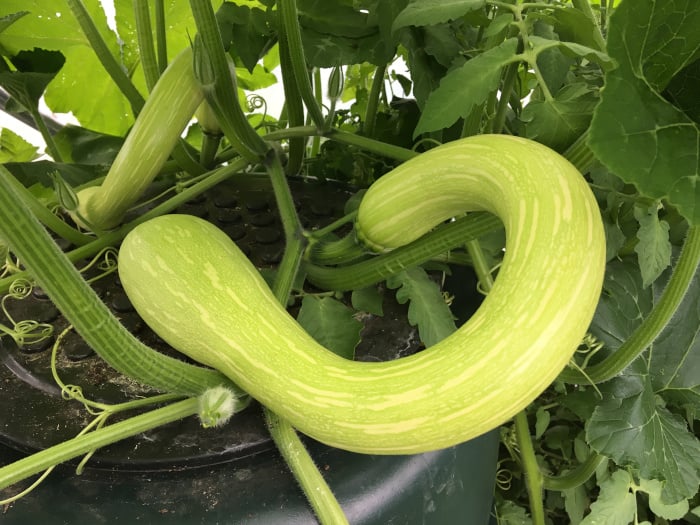Tromboncino squash is one of those squashes that you will not forget because of its distinctive curved shape. Tromboncino, which means little trombone in Italian, has a distinctive appearance like the musical instrument it is named after, with its slender appearance blooming into a bulbous end. While the squash is popular in Italy, it is not as well-known in other parts of the world. So, let’s find out more
about this wonderful squash.Tromboncino Squash
Tromboncino squash (Cucurbita moschata) is an Italian heirloom squash that can be eaten raw or cooked. An heirloom vegetable means that it is an old-time variety that has been passed down for generations through seed preservation. While squash is technically a fruit, it is cooked and used as a vegetable.
Tromboncino squash, a member of the Cucurbitaceae family, grows on climbing vines and is ideal for growing on a trellis or an archway. The squash needs enough room in the garden for it to hang and grow freely as it can go up to 2-3 kgs in weight. However, the sweet-tasting yellow-green fruit is well worth the effort as it is one of those few winter squashes that can also be harvested in the summer. In the winter, you will usually get to taste the young variety that has a sweet flavor and makes an excellent addition to salads. If you let it mature on the vine, it turns a lovely golden yellow. Mature tromboncino has a buttery taste and can be best likened to watery butternut squash. You can use it for soups and curries. [1] [2]
Tromboncino squash is also called climbing zucchini,Trombolino d’Albenga, Zuchetta rampicante, and serpentine squash.

Tromboncino squash is named after the trombone musical instrument. Photo Credit: Shutterstock
Nutrition Facts
According to the USDA, 100 grams of raw winter squash (about 2/3 cup) contains only 34 calories and 1.5 grams of dietary fiber. Like other squash varieties, tromboncino squash is rich in vitamins A and C and contains high levels of beta-carotene. For more information on winter squashes, you can head over to 11 Amazing Benefits Of Winter Squash. [3] [4]
How To Cook Tromboncino Squash?
All parts of the squash are edible, including its seeds. Here are the most common but delicious ways of using tromboncinos:
- Salads: If you manage to get a tender and young squash, the necks are usually seedless. This makes them perfect to serve as crudites to dip in hummus. You can also slice them thin and make it a part of salads.
- Side dish: Cube the squash and sauté it with olive oil, garlic, salt, and pepper. This simple side dish makes a great addition to summer tables. You can also sprinkle goat cheese on top to make it fancier.
- Soups: Tromboncino squash is delicious when used in soups. For a simple recipe, roast cubed or sliced squash in the oven and make a purée once cooled. In a large saucepan, add olive oil, chopped onion, and garlic. Stir till fragrant and add your favorite curry powder. You can also use Thai curry paste if you have it on hand. Let the spices release their aroma and add the puréed squash. Simmer till all the flavors come together. Add a little coconut cream to get a creamy consistency. This is one of the best soups to have on a chilly winter night.
- Pasta: In Italy, this squash is often stuffed in ravioli. You can make your own Italian version with sautéed squash, brown butter, and sage, and serve it with gnocchi.
- Tromboncino squash seeds: The seeds of the squash are edible and can be enjoyed raw or slightly roasted and salted.
- Tromboncino squash blossoms: The blossoms are absolutely delicious when stuffed with ricotta cheese and fried.



